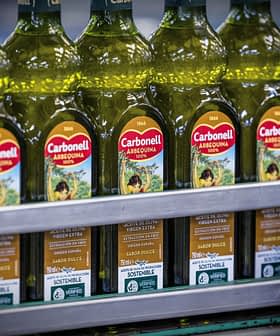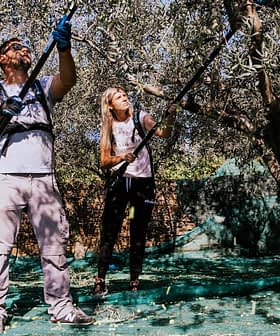Before becoming a farmer, Kathryn Keeler, the co-owner of Rancho Azul y Oro, had a high-paced, stressful job in the Los Angeles legal world, and wished for a different, slower-paced life.
Her grandfather’s love of the California hills led her to frequently spend weekends in the nearby Edna Valley with him, and they would explore the Paso Robles area.
One should not go into olive farming if they are not prepared to put in 110 percent of themselves and plan to produce the best olive oil in the world.
Eventually, they found a property and the land became an integral part of their family life. Over the next 10 years, Keeler split her time between working in Los Angeles and building the ranch. Finally, in 2015, the ranch became their new life and business.
Rancho Azul y Oro is now a boutique producer based in the hills of San Miguel on the Central Coast of California.
See Also:Producer ProfilesThe name means ‘blue and gold ranch,’ which Keeler told Olive Oil Times serves as a homage to her grandfather’s love of the land. Blue and gold are also California’s official state colors.
“If we were asked if we regretted our decision to do this, we would do it all over again,” she said. “It’s been an amazing adventure.”
While transitioning from city life to farming, Keeler said she came across plenty of challenges and had to learn a whole new set of skills.
“There are hard lessons, such as when a previous mill’s equipment broke, and our entire crop sat and did not get milled in time,” she said. “For every award, there are 100 losses, whether it’s non-delivery of bottles, tractors breaking, crew changes for harvest or weather changes.”

Sorting olives at Azul Rancho y Oro.
“One has to remain flexible and focused to get things done,” Keeler added. “There are times when life on our olive farm is as fast-paced as life in the legal world, such as around harvest.”
Rancho Azul y Oro earned a Gold Award at the 2022 NYIOOC World Olive Oil Competition for a robust blend of Frantoio, Coratina, Mission, Manzanilla, Pendolino and Arbequina olives.
“[Winning at the NYIOOC is] a true honor,” Keeler said. “Due to the high regard with which this competition is held, these awards are a reflection of past lessons learned, perseverance through difficult challenges and improvements we have made.”
A typical workday can start at 4:30 am during the harvest. However, the trees are pruned and cared for 365 days per year.
During the harvest, the olives are hand-picked and sorted, with any that do not meet Keeler’s standards discarded. She is vigilant of the weather while transporting the olives from the groves to the mill.
The primary aim is to mill the olives within 12 hours and it is not unusual for work to finish by midnight.

Taking olives to the mill. Photo: Rancho Azul y Oro
“The oil is picked up early the next day and we immediately begin preparing our samples for testing and certification,” she said. “Doing it right matters, whether you’re on a farm or in a law office in Los Angeles.”
“One should not go into olive farming if they are not prepared to put in 110 percent of themselves and plan to produce the best olive oil in the world,” Keeler added.
The reward of the breath-taking vistas and sunsets with a glass of wine after a long day makes the venture worthwhile for Keeler.
She added that the ranch is also the ideal place to celebrate special occasions, especially since the whole family has been involved in its evolution, from planting the olive trees to participating in the harvests and expanding and renovating the ranch.
Like the legal world, she said farming in California is a dynamic profession. Each year, she has to adapt to meet the state’s environmental challenges and the ever-changing U.S. olive oil market.
“Our foremost concern is growing conditions, the continued drought and managing olive tree diseases and pests,” Keeler said. “We installed additional, more streamlined irrigation this year and have honed our schedule for tree maintenance. Another major challenge this year is supply chain issues, as well as rising costs.”
She added they placed advance orders for bottles in October 2021, as shortages were anticipated, but these still have not been delivered. Keeler hopes the bottles will arrive in time for the 2022/23 harvest.
Other concerns are whether there will be a shortage of labor, even though the family does most of the work.

Rancho Azul y Oro
“All of our supply costs have risen dramatically, also shipping costs to our customers,” she said. “There is a price point beyond which customers are not willing to pay for premium olive oil, so we are working on ways to reduce our costs, the price of our products and shipping in a way that is fair to us, as well as to our customers.”
Her targeted customer base is exclusively online, specifically people living in areas where there is no local olive oil production. She added that Ranco Azul y Oro’s main competition comes from other producers in the area.
“From the beginning, due to our remote location, farm visits, tours and events would not be possible,” Keeler said. “We have planned to develop exclusively online sales to this targeted audience. We sell on several platforms and for each of the last two years, have been sold out before the next year’s harvest.”
Keeler prides herself on presenting a unique experience and encourages customers to get to know the farmers.
After every harvest, her team reviews the whole process and modifies it accordingly, especially if something did not go to plan.
“We review what the percentages of olive varietals were and develop our blend together, working also on product development for the next year,” Keeler said. “We bottle and label our oil together and personally gift wrap each package, and we get to know our customers.”
“Our customers share what’s going on in their lives with us, and we remember them and their stories,” she added. “They are not just orders to us; they are people.”
With the 2021 olive harvest now in the rearview mirror, Keeler said the company’s mission is to build on past foundations and continue improving its range of products “to provide exceptional customer service to our existing customers and increase our customer base.”
“Hopefully, we will have a successful harvest and return to the 2023 NYIOOC,” she concluded.









